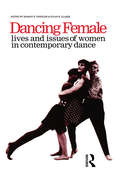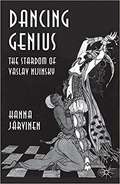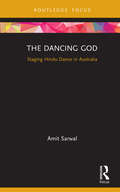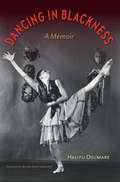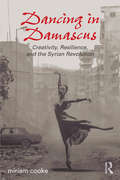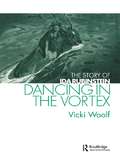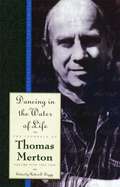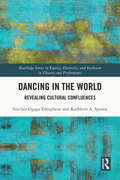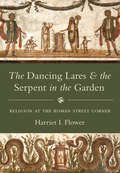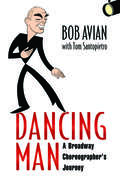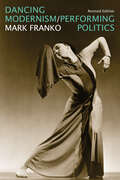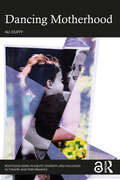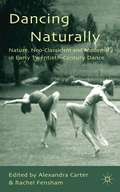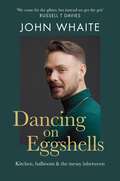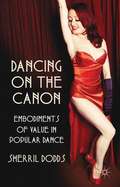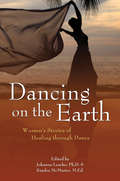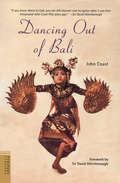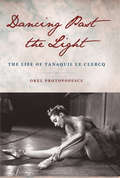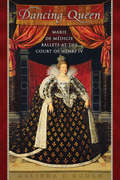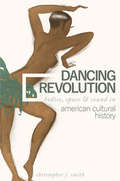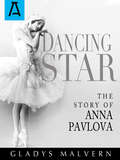- Table View
- List View
Dancing Female (Choreography and Dance Studies Series #Vol. 12)
by Sharon E. Friedler Susan B. GlazerFirst Published in 1997. Routledge is an imprint of Taylor & Francis, an informa company.
Dancing Genius: The Stardom of Vaslav Nijinsky
by Hanna JärvinenTracing the historical figure of Vaslav Nijinsky in contemporary documents and later reminiscences, Dancing Genius opens up questions about authorship in dance, about critical evaluation of performance practice, and the manner in which past events are turned into history.
The Dancing God: Staging Hindu Dance in Australia
by Amit SarwalThe Dancing God: Staging Hindu Dance in Australia charts the sensational and historic journey of de-provincialising and popularising Hindu dance in Australia. In the late nineteenth and early twentieth centuries, colonialism, orientalism and nationalism came together in various combinations to make traditional Hindu temple dance into a global art form. The intricately symbolic Hindu dance in its vital form was virtually unseen and unknown in Australia until an Australian impresario, Louise Lightfoot, brought it onto the stage. Her experimental changes, which modernised Kathakali dance through her pioneering collaboration with Indian dancer Ananda Shivaram, moved the Hindu dance from the sphere of ritualistic practice to formalised stage art. Amit Sarwal argues that this movement enabled both the authentic Hindu dance and dancer to gain recognition worldwide and created in his persona a cultural guru and ambassador on the global stage. Ideal for anyone with an interest in global dance, The Dancing God is an in-depth study of how a unique dance form evolved in the meeting of travellers and cultures.
Dancing in Blackness: A Memoir
by Halifu OsumareDancing in Blackness is a professional dancer's personal journey over four decades, across three continents and 23 countries, and through defining moments in the story of black dance in America. In this memoir, Halifu Osumare reflects on what blackness and dance have meant to her life and international career. Osumare's story begins in 1960s San Francisco amid the Black Arts Movement, black militancy, and hippie counterculture. It was there, she says, that she chose dance as her own revolutionary statement. Osumare describes her experiences as a young black dancer in Europe teaching "jazz ballet" and establishing her own dance company in Copenhagen. Moving to New York City, she danced with the Rod Rodgers Dance Company and took part in integrating the programs at the Lincoln Center. After doing dance fieldwork in Ghana, Osumare returned to California and helped develop Oakland’s black dance scene. Osumare introduces readers to some of the major artistic movers and shakers she collaborated with throughout her career, including Katherine Dunham, Pearl Primus, Jean-Leon Destine, Alvin Ailey, and Donald McKayle. Now a black studies scholar, Osumare uses her extraordinary experiences to reveal the overlooked ways that dance has been a vital tool in the black struggle for recognition, justice, and self-empowerment. Her memoir is the inspiring story of an accomplished dance artist who has boldly developed and proclaimed her identity as a black woman.
Dancing in Damascus: Creativity, Resilience, and the Syrian Revolution
by miriam cookeOn March 17, 2011, many Syrians rose up against the authoritarian Asad regime that had ruled them with an iron fist for forty years. Initial successes were quickly quashed, and the revolution seemed to devolve into a civil war pitting the government against its citizens and extremist mercenaries. As of late 2015, almost 300,000 Syrians have been killed and over half of a total population of 23 million forced out of their homes. Nine million are internally displaced and over four million are wandering the world, many on foot or in leaky boats. Countless numbers have been disappeared. These shocking statistics and the unstoppable violence notwithstanding, the revolution goes on. The story of the attempted crushing of the revolution is known. Less well covered has been the role of artists and intellectuals in representing to the world and to their people the resilience of revolutionary resistance and defiance. How is it possible that artists, filmmakers and writers have not been cowed into numbed silence but are becoming more and more creative? How can we make sense of their insistence that despite the apocalypse engulfing the country their revolution is ongoing and that their works participate in its persistence? With smartphones, pens, voices and brushes, these artists registered their determination to keep the idea of the revolution alive. Dancing in Damascus traces the first four years of the Syrian revolution and the activists’ creative responses to physical and emotional violence.
Dancing in the Vortex: The Story of Ida Rubinstein (Choreography and Dance Studies Series #Vol. 20.)
by Vicki WoolfParis at the turn of the century - Art Nouveau, Renoir, Toulouse-Lautrec and the Folies Bergere. This was the atmosphere which nurtured the artistic development of the remarkable dancer and choreographer Ida Rubinstein.This long-awaited biography gives us a unique insight into the life of a remarkable woman, responsible for a fascinating chapter of our artistic heritage. She was a chameleon, a diva, who lived many lives, overcoming the anti-Semitism of her times to enchant and captivate the highest of societies.Untrained as a dancer, Ida Rubinstein's charisma attracted collaborators such as Debussy, Stravinsky, Ravel, Cocteau, Bakst, and Benois.
Dancing in the Water of Life
by Thomas MertonThe sixties were a time of restlessness, inner turmoil, and exuberance for Merton during which he closely followed the careening development of political and social activism - Martin Luther King, Jr., and the March on Selma, the Catholic Worker Movement, the Vietnam war, and the assassination of John F. Kennedy. Volume 5 chronicles the approach of Merton's fiftieth birthday and marks his move to Mount Olivet, his hermitage at the Abbey of Gethsemani, where he was finally able to fully embrace the joys and challenges of solitary life: 'In the hermitage, one must pray of go to seed. The pretense of prayer will not suffice. Just sitting will not suffice . . . Solitude puts you with your back to the wall (or your face to it!), and this is good' (13 October, 1964).
Dancing in the Water of Life
by Thomas MertonThe sixties were a time of restlessness, inner turmoil, and exuberance for Merton during which he closely followed the careening development of political and social activism - Martin Luther King, Jr., and the March on Selma, the Catholic Worker Movement, the Vietnam war, and the assassination of John F. Kennedy. Volume 5 chronicles the approach of Merton's fiftieth birthday and marks his move to Mount Olivet, his hermitage at the Abbey of Gethsemani, where he was finally able to fully embrace the joys and challenges of solitary life: 'In the hermitage, one must pray of go to seed. The pretense of prayer will not suffice. Just sitting will not suffice . . . Solitude puts you with your back to the wall (or your face to it!), and this is good' (13 October, 1964).
Dancing in the World: Revealing Cultural Confluences (Routledge Series in Equity, Diversity, and Inclusion in Theatre and Performance)
by Sinclair Ogaga Emoghene Kathleen A. SpanosHow can we create more inclusive spaces in the field of dance? This book presents a framework for dance practitioners and researchers working in diverse dance cultures to navigate academia and the professional dance field. The framework is based on the idea of "cultural confluences," conjuring up an image of bodies of water meeting and flowing into and past one another, migrating through what they refer to as the mainstream and non-mainstream. These streams are fluid categories that are associated with power, privilege, and the ability (or inability) to absorb other cultural forms in shared dance spaces. In reflective interludes and dialogues, Emoghene and Spanos consider the effects of migration on their own individual experiences in dance to understand what it means to carry culture through the body in various spaces. Through an analysis of language, aesthetic values, spaces, creative processes, and archival research practices, the book offers a collaborative model for communicating the value that marginalized dance communities bring to the field. This book will be of great interest to students, scholars, and arts administrators in dance.
The Dancing Lares and the Serpent in the Garden: Religion at the Roman Street Corner
by Harriet I. FlowerThe most pervasive gods in ancient Rome had no traditional mythology attached to them, nor was their worship organized by elites. Throughout the Roman world, neighborhood street corners, farm boundaries, and household hearths featured small shrines to the beloved lares, a pair of cheerful little dancing gods. These shrines were maintained primarily by ordinary Romans, and often by slaves and freedmen, for whom the lares cult provided a unique public leadership role. In this comprehensive and richly illustrated book, the first to focus on the lares, Harriet Flower offers a strikingly original account of these gods and a new way of understanding the lived experience of everyday Roman religion.Weaving together a wide range of evidence, Flower sets forth a new interpretation of the much-disputed nature of the lares. She makes the case that they are not spirits of the dead, as many have argued, but rather benevolent protectors—gods of place, especially the household and the neighborhood, and of travel. She examines the rituals honoring the lares, their cult sites, and their iconography, as well as the meaning of the snakes often depicted alongside lares in paintings of gardens. She also looks at Compitalia, a popular midwinter neighborhood festival in honor of the lares, and describes how its politics played a key role in Rome’s increasing violence in the 60s and 50s BC, as well as in the efforts of Augustus to reach out to ordinary people living in the city’s local neighborhoods.A reconsideration of seemingly humble gods that were central to the religious world of the Romans, this is also the first major account of the full range of lares worship in the homes, neighborhoods, and temples of ancient Rome.Some images inside the book are unavailable due to digital copyright restrictions.
Dancing Man: A Broadway Choreographer's Journey
by Bob AvianTony and Olivier Award–winning Bob Avian’s dazzling life story, Dancing Man: A Broadway Choreographer’s Journey, is a memoir in three acts. Act I reveals the origins of one of Broadway’s legendary choreographers who appeared onstage with stars like Barbra Streisand and Mary Martin all before he was thirty. Act II includes teaching Katharine Hepburn how to sing and dance in Coco and working with Stephen Sondheim and Michael Bennett while helping to choreograph the original productions of Company and Follies. During this time, Avian won a Tony Award as the cochoreographer of A Chorus Line and produced the spectacular Tony Award–winning Dreamgirls. For a triumphant third act, Avian choreographed Julie Andrews’s return to the New York stage, devised all of the musical staging for Miss Saigon and Sunset Boulevard, and directed A Chorus Line on Broadway. He worked with the biggest names on Broadway, including Andrew Lloyd Webber, Carol Burnett, Jennifer Holliday, Patti LuPone, Elaine Stritch, and Glenn Close. Candid, witty, sometimes shocking, and always entertaining, here at last is the ultimate up-close and personal insider’s view from a front row seat at the creation of the biggest, brightest, and best Broadway musicals of the past fifty years.
Dancing Modernism / Performing Politics
by Mark FrankoIn the much-anticipated update to a classic in dance studies, Mark Franko analyzes the political aspects of North American modern dance in the 20th century.A revisionary account of the evolution of modern dance, this revised edition of Dancing Modernism / Performing Politics features a foreword by Juan Ignacio Vallejos on Franko's career, a new preface, a new chapter on Yvonne Rainer, and an appendix of left-wing dance theory articles from the 1930s. Questioning assumptions that dancing reflects culture, Franko employs a unique interdisciplinary approach to dance analysis that draws from cultural theory, feminist studies, and sexual, class, and modernist politics. Franko also highlights the stories of such dancers as Isadora Duncan, Martha Graham, and even revolutionaries like Douglas Dunn in order to upend and contradict ideas on autonomy and traditionally accepted modernist dance history.Revealing the captivating development of modern dance, this revised edition of Dancing Modernism / Performing Politics will fascinate anyone interested in the intersection of performance studies, history, and politics.
Dancing Motherhood (Routledge Series in Equity, Diversity, and Inclusion in Theatre and Performance)
by Ali DuffyDancing Motherhood explores how unique factors about the dance profession impact pregnant women and mothers working in it. Ali Duffy introduces the book by laying a foundation of social and cultural histories and systemic structures and power that shape the issues mothers in dance negotiate today. This book then reveals perspectives from mothers in dance working in areas such as performance, choreography, dance education, administration, and advocacy though survey and interview data. Based on participant responses, recommendations for changes in policy, hiring, evaluation, workplace environment, and other professional and personal practices to better support working mothers in dance are highlighted. Finally, essays from eight working mothers in dance offer intimate, personal stories and guidance geared to mothers, future mothers, policymakers, and colleagues and supervisors of mothers in the dance field. By describing lived experiences and offering suggestions for improved working conditions and advocacy, this book initiates expanded discussion about women in dance and promotes change to positively impact dancing mothers, their employers, and the dance field.
Dancing Naturally
by Alexandra Carter Rachel FenshamA renewed interest in nature, the ancient Greeks, and the freedom of the body was to transform dance and physical culture in the early twentieth century. The book discusses the creative individuals and developments in science and other art forms that shaped the evolution of modern dance in its international context.
Dancing on Eggshells: Kitchen, ballroom & the messy inbetween
by John Whaite'We come for the glitter, but instead we get the grit, in stories told with insight, tenderness and joy.' - Russell T DaviesWith a foreword by Steph McGovern'I never thought I'd write a memoir. I never thought I'd do a lot of the things I have done in my thirty-four years, but life has a wonderful way of surprising us.'Well-known as the winner of the third series of The Great British Bake Off and runner up of Strictly Come Dancing with his same-sex dance partner Johannes Radebe, John Whaite's personal story is a complicated narrative of contradictions, highs and lows, told with tenderness, joy, insight and wit, but also unflinching honesty. A shy little boy from rural Lancashire, who was scared to sleep alone and danced a little 'too gay' at family weddings, he was also an unruly teen who shaved a checkerboard pattern into his hair and refused to conform. From childhood his life has revolved around food - his parents owned a fish and chip shop where John worked in the back peeling potatoes - but for long periods he has been haunted by bulimia and body dysmorphia and not a day goes by when he doesn't worry about what or how much he eats. He achieved TV fame but then seemingly wilfully chose to self-destruct, before finding the strength to pull back when he woke up in a car with half a kebab at his feet and chilli sauce on his shoes. Through it all, his essential optimism has meant that he has chosen to take every step back as a chance to reassess and begin again, finally arriving at the realisation that external validation and fulfilment is transient - a distraction from the sometimes painful pilgrimage we make as we gain wisdom from our experiences.
Dancing on Eggshells: Kitchen, ballroom & the messy inbetween
by John Whaite'We come for the glitter, but instead we get the grit, in stories told with insight, tenderness and joy.' - Russell T DaviesWith a foreword by Steph McGovern'I never thought I'd write a memoir. I never thought I'd do a lot of the things I have done in my thirty-four years, but life has a wonderful way of surprising us.'Well-known as the winner of the third series of The Great British Bake Off and runner up of Strictly Come Dancing with his same-sex dance partner Johannes Radebe, John Whaite's personal story is a complicated narrative of contradictions, highs and lows, told with tenderness, joy, insight and wit, but also unflinching honesty. A shy little boy from rural Lancashire, who was scared to sleep alone and danced a little 'too gay' at family weddings, he was also an unruly teen who shaved a checkerboard pattern into his hair and refused to conform. From childhood his life has revolved around food - his parents owned a fish and chip shop where John worked in the back peeling potatoes - but for long periods he has been haunted by bulimia and body dysmorphia and not a day goes by when he doesn't worry about what or how much he eats. He achieved TV fame but then seemingly wilfully chose to self-destruct, before finding the strength to pull back when he woke up in a car with half a kebab at his feet and chilli sauce on his shoes. Through it all, his essential optimism has meant that he has chosen to take every step back as a chance to reassess and begin again, finally arriving at the realisation that external validation and fulfilment is transient - a distraction from the sometimes painful pilgrimage we make as we gain wisdom from our experiences.
Dancing on the Canon
by Sherril DoddsEmploying a cultural theory approach, thisbook explores the relationship between popular dance and value. It traces the shifting value systems that underpin popular dance scholarship and considers how different dancing communities articulate complex expressions of judgment, significance and worth through their embodied practice. "
Dancing on the Earth
by Sandra Mcmaster Johanna LesehoThe essays in this dynamic compilation are a testament to dance as a healing art. Widely interdisciplinary in nature and written by women dancers from around the world, they illustrate a rich array of dance practices, cultures, and disciplines and show how this expressive therapy can be both empowering and exhilarating. The women's narratives all share a deep appreciation for the connection between mental, spiritual, and physical dimensions, offering dance as a transformative power of renewing and rebuilding that bond. Both personal and professional, the stories weave a vivid tapestry of lived experiences and insights, balance, and a community healed by dance.
Dancing Out of Bali
by Richard Attenborough John Coast"It is Bali felt, understood, loved, communicated...Coast has a kind of word magic." --New York Herald TribuneThis book tells of a young Englishman, fresh out of a Japanese prison camp, and his Javanese wife, and how they leave Indonesia for the footlights of Broadway. This is a story of life, music, and dancing in Bali, with all the charm of the Balinese people. Dancing out of Bali is a truly remarkable personal adventure story for all readers, especially dance lovers.
Dancing Out of Bali
by John Coast Richard Attenborough"If you know where to look, you can still discover and recognize what it was that intoxicating John Coast fifty years ago." -Sir David AttenboroughThis book is one of the great classics about Bali, now with dozens of illustrations and photographs.Dancing out of Bali is a fascinating personal account of a young Englishman who settled in a small house in Bali in the midst of the political turmoil that griped post-war Indonesia. There, he immersed himself in Balinese culture and made ambitious plans to bring a troupe of Balinese dancers and musicians to Europe and America. The book relates John Coast's daring and remarkable adventure that took him from revolution in Indonesia to the footlights of London and Broadway. Within a few weeks, the troupe had captured the hearts of audiences. Here are photographs of Bali and stories of the performer's magic island and of the enchanting dancers, including the beautiful 12-year-old Ni Gusti Raka. She became a star overnight and delighted audiences everywhere during the troupe's triumphant tour.It is also a story of Balinese culture and life in Bali-following the devastating Japanese occupation-of music and dancing in Bali, of many of the island's great performing dancers and musicians,
Dancing Out of Bali
by John Coast Richard Attenborough"It is Bali felt, understood, loved, communicated...Coast has a kind of word magic." --New York Herald TribuneThis book tells of a young Englishman, fresh out of a Japanese prison camp, and his Javanese wife, and how they leave Indonesia for the footlights of Broadway. This is a story of life, music, and dancing in Bali, with all the charm of the Balinese people. Dancing out of Bali is a truly remarkable personal adventure story for all readers, especially dance lovers.
Dancing Past the Light: The Life of Tanaquil Le Clercq
by Orel ProtopopescuA world-famous ballerina’s dramatic life Dancing Past the Light cinematically illuminates the glamorous and moving life story of Tanaquil “Tanny” Le Clercq (1929‒2000), one of the most celebrated ballerinas of the twentieth century, describing her brilliant stage career, her struggle with polio, and her important work as a dance teacher, coach, photographer, and writer. Born in Paris, Le Clercq became a principal dancer with the New York City Ballet at age 19 and a role model for aspiring dancers everywhere. Orel Protopopescu recounts Le Clercq’s intense marriage to the company’s renowned choreographer George Balanchine, for whom Le Clercq was a muse, the prototype of the exquisite, long-limbed “Balanchine ballerina.” Enhanced with a wealth of previously unpublished photos, personal letters, and sketches by Balanchine, this book offers an intimate portrait of Le Clercq’s dancing life and her relationship to the man who was both her mentor and husband. It delves into her friendships with other dancers as well, including a longtime rival for her affections, choreographer Jerome Robbins. Le Clercq contracted polio while on tour in Europe at age 27 and would never dance again. This book offers a rare account of how Le Clercq grappled with a fate considered unimaginable for a ballerina and began to share her love of dance as a writer and dance teacher. It also highlights Le Clercq’s role in the struggles for racial equality and disability rights. Her art was her vehicle: she and Arthur Mitchell made history as the couple in New York City Ballet’s first interracial pas de deux at City Center in 1955 and later she taught from a wheelchair at his Dance Theatre of Harlem. With insights from interviews with her friends, students, and colleagues, Dancing Past the Light depicts the joys and the dark moments of Le Clercq’s dramatic life, celebrating her mighty legacy.
Dancing Queen: Marie de Médicis' Ballets at the Court of Henri IV
by Melinda GoughUnder glittering lights in the Louvre palace, the French court ballets danced by Queen Marie de Médicis prior to Henri IV’s assassination in 1610 attracted thousands of spectators ranging from pickpockets to ambassadors from across Europe. Drawing on newly discovered primary sources as well as theories and methodologies derived from literary studies, political history, musicology, dance studies, and women’s and gender studies, Dancing Queen traces how Marie’s ballets authorized her incipient political authority through innovative verbal and visual imagery, avant-garde musical developments, and ceremonial arrangements of objects and bodies in space. Making use of women’s "semi-official" status as political agents, Marie’s ballets also manipulated the subtle social and cultural codes of international courtly society in order to more deftly navigate rivalries and alliances both at home and abroad. At times the queen’s productions could challenge Henri IV’s immediate interests, contesting the influence enjoyed by his mistresses or giving space to implied critiques of official foreign policy, for example. Such defenses of Marie’s own position, though, took shape as part of a larger governmental program designed to promote the French consort queen’s political authority not in its own right but as a means of maintaining power for the new Bourbon monarchy in the event of Henri IV’s untimely death.
Dancing Revolution: Bodies, Space, and Sound in American Cultural History (Music in American Life)
by Christopher J. SmithThroughout American history, patterns of political intent and impact have linked the wide range of dance movements performed in public places. Groups diverse in their cultural or political identities, or in both, long ago seized on dancing in our streets, marches, open-air revival meetings, and theaters, as well as in dance halls and nightclubs, as a tool for contesting, constructing, or reinventing the social order. Dancing Revolution presents richly diverse cases studies to illuminate these patterns of movement and influence in movement and sound in the history of American public life. Christopher J. Smith spans centuries, geographies, and cultural identities as he delves into a wide range of historical moments. These include: the God-intoxicated public demonstrations of Shakers and Ghost Dancers in the First and Second Great Awakenings; creolized antebellum dance in cities from New Orleans to Bristol; the modernism and racial integration that imbued twentieth-century African American popular dance; and public movement's contributions to hip hop, anti-hegemonic protest, and other contemporary transgressive communities’ physical expressions of dissent and solidarity. Multidisciplinary and wide-ranging, Dancing Revolution examines how Americans turned the rhythms of history into the movement behind the movements.
Dancing Star: The Story of Anna Pavlova
by Gladys MalvernIn this biographical novel, Gladys Malvern shares the incredible story of Anna Pavlova, one of the most revered and celebrated ballerinas of all time. Malvern presents Pavlova's life in enchanting prose, allowing the reader to experience Pavlova's inspirational first exposure to a performance of Sleeping Beauty, the origination of her defining dance The Dying Swan, her illustrious rise to fame as a prima ballerina, and her extensive world tours. You don't have to be a fan of the ballet to enjoy this captivating tale, available for the first time in ebook.
